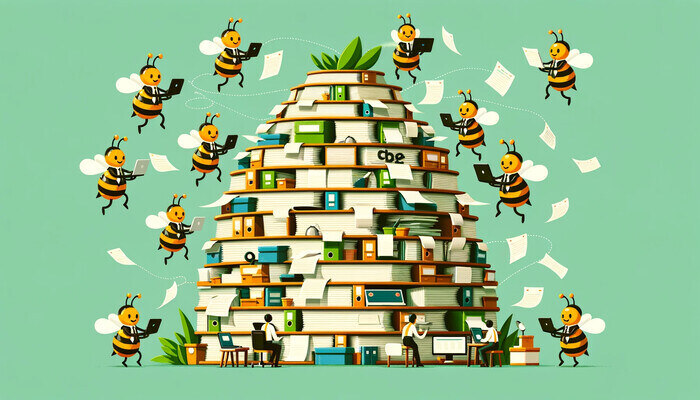The Role of Content Strategy in Technical Writing
 Elmirain Technical Writing on 1/10/2024 — 6 minute read
Elmirain Technical Writing on 1/10/2024 — 6 minute read Elmirain Technical Writing on 1/10/2024 — 6 minute read
Elmirain Technical Writing on 1/10/2024 — 6 minute read

A content strategy delineates the information that your documents should encompass, their structural organization, and the specific audience they should target. It is constructed upon an extensive knowledge base, commonly referred to as a company wiki. An ambiguous content policy can render your documentation ineffective, impacting both customers and in-house users.
The objective of this blog is to elucidate the meaning of a content strategy, detailing how to develop and optimize it for efficiency.
A content strategy serves as the guiding philosophy for your company’s knowledge base, encompassing goals, objectives, architecture, design, and the ideas it conveys. An effective content strategy is thought to enhance documentation in two key ways:
These two requirements define major trends in shaping your documentation – content targeting (focus on internal and external audiences) and multi-channel publishing.
These strategic content development trends allow the creation of high-quality, engaging, and relevant content for various user types (developers, admins, managers, and common users). They also ensure access to different document formats through publishing via multiple channels. Without this, it becomes challenging to align documentation with audience preferences and provide users with content formats that meet their needs.
Multi-channel publishing is a strategic necessity due to the diversity of tools and communication channels used by consumers today, such as websites, social media, mobile apps, and online stores. Each platform requires a specific format (HTML for websites, eBooks and PDFs for online stores, etc.).
The other trend involves personalizing (targeting) content to reach different audiences, closely tied to content reuse that allows for producing similar content for diverse groups. This is crucial for businesses seeking to maximize their online reach and engagement.
The purpose of a content strategy is to improve communication with both customers and the internal target audience by offering clear and comprehensive information that supports each digital product or project.
A robust content strategy hinges on the effective utilization of the company’s knowledge base, positioning it as a valuable asset akin to human resources, finances, and equipment. However, if the knowledge base remains underutilized, employees cannot leverage its full potential, hindering their ability to reuse it for generating new content.
In the worst-case scenario, technical writers and other staff members may be unaware of existing documents or uncertain about those in development or requiring updates. This lack of clarity can lead to conflicts between different document versions, resulting in downtime and financial losses.
To ensure the success of your content strategy, consider the three key elements that define contemporary content management.
Content reuse. In the current landscape, content creation marks only the initial phase of the content’s operational life. After creation, content finds a home in the company’s knowledge base. The purpose of storing this content is not arbitrary; it’s meant for reuse.
Content reuse involves tapping into stored content as ready-made texts or code samples. Failing to utilize available content would be counterproductive.
The content operation life should follow a cycle of creation, initial use, first reuse, second reuse, third reuse, and so forth.
Accessibility to relevant information is crucial for the continuous reuse of content by your team of technical writers in crafting new documents.
Content repurposing. The repurposing of content is closely related to content reuse. Repurposed content is content reused with minor modifications. Adjustments are made to cater to different audiences or to cover the features of new products, versions, or updates. A robust content strategy should facilitate easy content repurposing. In platforms like ClickHelp, this is achieved through conditional blocks and snippets, streamlining the process of modifying content for different target audiences.
Multi-channel publishing. An invaluable tool for content targeting, multi-channel publishing enables the use of different channels to diversify the target audience of your digital product. Without it, your audience is confined to a single channel, such as HTML. However, considering readers who may prefer downloading help docs in PDF, EPUB, or MOBI formats, a comprehensive publication strategy should encompass all possible formats. Providing convenient ways for your audience to engage with your content is essential for effective outreach.
Your publication strategy must encompass all possible formats. Without providing convenient ways for readers to engage with your content, reaching them becomes challenging.

A documentation strategy encompasses various facets, including the management of the company’s information base, product/service documentation, and standard operating procedures (SOPs). Internally, SOPs hold particular prominence as they detail all company processes.
SOPs can manifest in diverse document types that regulate specific processes. For instance, in a production facility, an SOP might take the form of instructions for starting up or shutting down complex equipment like a CNC machining center. Conversely, a SOP could have simpler content, such as guidelines on using personal protective equipment in a workshop.
In the realm of digital product development, a prime example of an SOP is a product requirements document (PRD), providing detailed instructions on building a digital product.
These are just a few illustrations; in reality, SOPs or process guides can span as many documents as there are processes in a company.
Beyond internal documents, an effective content strategy should prioritize documents tailored to customers. This emphasis on customers is crucial, as they seek comprehensive support materials to avoid reaching out to the product support team. Quick start guides, operating manuals, troubleshooting guides, and similar documents should be readily accessible. This not only enhances customer satisfaction and UX parameters but also reduces the volume of customer inquiries, ultimately saving the support team’s time.
A robust content strategy should ensure the effectiveness of the company’s knowledge base both internally and externally, catering to the needs of in-house users and customers alike.
A comprehensive content strategy should address the following key areas:
Each of these areas should be represented by high-quality, manageable, and reusable documentation. It’s crucial to note that documentation extends beyond technical documents, encompassing information disseminated through blogs, articles on platforms like Hacker news, and social networks. The primary goals of this information are to attract more customers by stimulating demand for your product and fostering customer loyalty. The latter is achieved when customers observe that specialists carefully explain any queries that arise.
A content strategy’s efficiency cannot be assessed without appropriate tools. These tools encompass various metrics related to feedback data, enabling the measurement of parameters such as customer support tickets, requests, bounce rates, likes, dislikes, and their ratios.
At present, content creation has become significantly more effective compared to 5 or 10 years ago, thanks to the introduction of component authoring, which has streamlined the technical writing process. Modern help authoring tools now facilitate the efficient reuse of your company’s entire knowledge base, treating all created texts and codes as ‘bricks’ for constructing new content.
ClickHelp stands out as one such tool—an online documentation creation, development, and management platform. This authoring software empowers your technical writers to generate fresh content easily from the existing information base.
Component authoring is intricately linked to the principle of single-sourcing. This principle allows you to connect new content units to the source ones, simplifying the updating process. When you update the source text, all single-sourced components are automatically updated, saving your team a substantial amount of time. No longer do they need to individually edit and update similar texts.
Consequently, the tasks of repurposing content and multi-channel publishing have become significantly more straightforward.

If you’re still uncertain about the effectiveness of your content strategy, pose critical questions: Is it truly efficient? Does it contribute to attracting new customers or fostering loyalty among your existing target audience? If the answer is negative, your company’s content strategy may require fundamental changes. Consider adopting new content management tools. These tools can facilitate content reuse and content repurposing and enhance the precision of targeting your audience more effectively.
Good luck with your technical writing!
ClickHelp Team
Author, host and deliver documentation across platforms and devices
Get monthly digest on technical writing, UX and web design, overviews of useful free resources and much more.
"*" indicates required fields